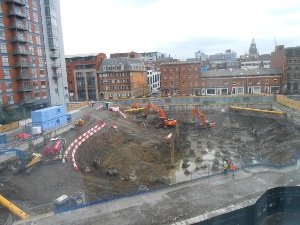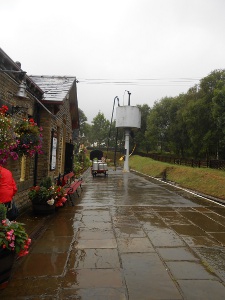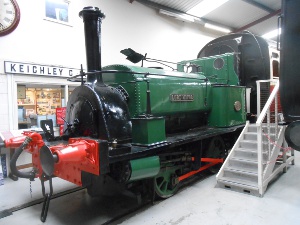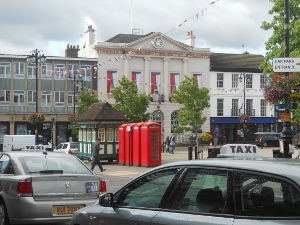We have been crisscrossing Britain, because we enjoy train riding. We decided which cities we wanted to visit, then arranged them in order of Interesting Train  View From our Window
Rides. This has involved unexpected issues, such as passing through Manchester several times just because that is what the trains do, but it also introduced us to some interesting fellow passengers and allowed us to see thousands upon thousands of sheep in pastures along the routes.
View From our Window
Rides. This has involved unexpected issues, such as passing through Manchester several times just because that is what the trains do, but it also introduced us to some interesting fellow passengers and allowed us to see thousands upon thousands of sheep in pastures along the routes.
In Leeds, we stayed at a Novotel hotel close to our train station and across the street from a large construction site. We have surely enjoyed it -- lopping off concrete pillars, scooping from small scoops into bigger scoops and then into trucks lined up to haul off the stuff. It was an old building down there, with pilings and pillars and foundations, and of course every day the gentle showers fill the hole up with water and they've got to pump it out.
The Leeds city museum, all in all, is a warm friendly place, with a great deal of focus on being an educational institution which should appeal to all,  An Extinct Moa
especially the young. The exhibits go from geological time to the present, and all points in between. We most enjoyed a short film interviewing citizens who had lived for some time in what are called back-to-back houses. Although it's a small museum, we had the feeling that students could return many times, and still learn a lot. For example, we saw our first moa skeleton - it had only been a crossword puzzle word before. We're glad the museum curators saved the Victorian statue of Circe - it's a jim-dandy!
An Extinct Moa
especially the young. The exhibits go from geological time to the present, and all points in between. We most enjoyed a short film interviewing citizens who had lived for some time in what are called back-to-back houses. Although it's a small museum, we had the feeling that students could return many times, and still learn a lot. For example, we saw our first moa skeleton - it had only been a crossword puzzle word before. We're glad the museum curators saved the Victorian statue of Circe - it's a jim-dandy!
One new attraction receiving lots of attention is the Royal Armouries Museum, a national museum of arms and armor.
The building itself is snazzy -- maybe ten years old now and still solid and modern. The fact that it is on the edge of the River Aire means that we found a part of Leeds which was absolutely new to us even after several days of dedicated sightseeing in the city center.
The displays are striking and the objects are well identified. Several large exhibits are eye-catching, e.g., hunting chamois, traveling by elephant, hunting waterfowl. The museum includes the only known set of elephant armor. The subjects are divided into several categories, each with its own gallery, such as Hunting, Self-Defense, Presentation Arms, Tournaments.
 Hunting at Armouries
Hunting at Armouries
The museum is especially popular with small boys and their parents, from what we saw this morning. A large play area with costumes is designed for children from toddler to 8 year-old and was being well used. Because this is an Armoury museum and not a War Museum like the Imperial War Museum, questions about the effect of armour and weapons technology on warfare, strategy and tactics, and killing in general are not raised here.
We found some of the most engaging experiences in the country just outside metropolitan Leeds.
Worth Valley
Start with the weather. It rained today - not a very heavy rain by our standards - certainly not a cloudburst or downpour, just a steady rain for an hour and then a light rain for several more hours and then sprinkles and finally sunshine when we returned to Leeds. So by our standards the weather was not an impediment. But the U.K. weather service had told the locals they were getting the tail end of Hurricane Bertha, so they were determined the weather was a big deal. One of the museums we intended to visit was closed, and a tour bus operator cancelled his tour, both on account of the weather. The tour bus was an heirloom, an old fashioned double decker bus from the sixties, and the driver said it wouldn't be safe because of the rain coming in. Of course there weren't many customers either ...
Still, the day was a remarkable success. It was all about nostalgia. Railroad nostalgia, in the country which gave birth to the railroad, and has hundreds, if not thousands of old railroad cars to lovingly preserve, along with a similar number of old railroad stations, some just a mile apart. That was the case today with the Keighley and Worth Valley Railway, just five miles up the hill from Keighley to Oxenhope, with stops at Ingrow West, Damems, Oakworth, and Haworth in between.
 On the Worth Valley Railroad
On the Worth Valley Railroad
We arrived early and purchased two "rover" tickets which allowed us to board and alight anywhere we wished. The first trip up the hill (660 feet above sea level at Oxenhope) was in a 1960s-era single diesel car, which British Rail had thought would be economically viable. It was neat because we could see all the rigamarole with operating the train as well as all the lovely stations.
Not only were the stations clean and freshly painted, they were all kitted out with old advertising signs (Rinso, Virol,...), old baggage carts and dollies piled with old luggage or milk cans, vintage mailboxes, old blackboard displays, old station signs, old signal equipment,... in short, everything that tended to move the passenger back in time to the post-WWII era, the heyday of trains, before either air or motor travel had helped to drive the passenger trains nearly out of business in the U.S. and into a drastically reduced privatized system in the U.K.
 Water Tank for Refills
Water Tank for Refills
Today was a "blue Sunday," one of the days when the old steam engines and older carriages are dusted off and run for the day's excursions. There are eleven trips up and eleven trips down, which keeps the staff quite busy. It's a working railway, but in fact owned, managed and operated by the volunteer members, so a lot of English love is entered into the system to create that wonderful nostalgia.
About half-way up the hill the train stopped at a switching station, with many large switches to control the track and allow trains to pass one another in opposite directions. The conductor carried a roughly cylindrical piece of steel about eighteen inches long to the man inside the switch station, who inserted the piece of metal and then proceeded to change a couple of switches, and gave the conductor another esoteric piece of railroad stuff which the conductor passed to the engineer, and then we continued on up.
At Oxenhope we first found the station cafe where we could partake of tea and scones whilst sitting in a railroad dining car - that generated some nostalgia. We noted a large water tank to replenish the boilers of the steam engines. Then we crossed the platform to a museum with lots of train cars on display - more nostalgia.
We caught the next train, pulled by a steam engine, to Haworth, where the Bronte sisters did their writing, and examined the extremely well-stocked station store, filled with books, magazines, collectibles and models for railroad enthusiasts.
There was a lovely old bus sitting outside the station, and our Rover ticket entitled us to a free bus ride up over the hill top to Oxenhope again. One of the many volunteers was a young man who served as conductor on the bus, collecting tickets and pushing the bells to notify the driver to continue on the route. Everyone dressed in the correct period uniforms.
 In the Worth Valley Museum
In the Worth Valley Museum
Back in Oxenhope, several things happened: (a) the rain picked up; (b) a bus tour was cancelled by the driver; (c) many families with small children appeared at the station; and (d) special train cars were placed on the railroad by the Lancashire and Yorkshire Railway Trust, which owns carriages #1507, 1474, and 47, built from 1880 to 1912.
With the bus tour cancelled, we decided to return to Ingrow West and see the museums there. So we boarded another train to descend the hill and walked to the Museum of Rail Travel, which is operated by the Vintage Carriages Trust.
Inside the museums are a large library of old railroad books and magazines, many hundreds of wonderful old railroad signs, and some fifteen or twenty locomotives and carriages, many of which had been rigged up so the visitor could enter. We happily wandered through, sat in the seats in first, second, and third class carriages, and absorbed more lovely nostalgia.
 Greeted by a Band Concert
Greeted by a Band Concert
The second museum in Ingrow West would have shown us locomotive maintenance and repair, along with more vintage locomotives, but the man who runs that had decided the rainy weather was too chancy and stayed home.
But never mind, we got to talking with the station master (we actually chatted with nearly a dozen of the volunteers during the day) who evidently took a liking to us, because he showed us to a particular first class cabin for the final trip back to Keighley. We didn't quite understand why it was so special until we reached Keighley and saw that our cabin stopped right in front of the large brass band that was playing a train-welcoming concert as we pulled into the station. Wow! So the serendipity kicked in at the end of the day's outing and we had a very happy return to our hotel in Leeds.
Ripon
Ripon is said to be the smallest city in England, certainly the smallest cathedral city, and may even have the smallest cathedral. It's an old city, the summer retreat of the Archbishop of York, who at one time was coequal with the Archbishop of Canterbury. It has a fine central square with a tall cenotaph, unfortunately surrounded by parked cars.
On the city hall is the text "Except ye Lord keep ye cittie ye wakeman waketh in vain." Prior to 1604 when Ripon acquired a mayor, the principal government leader was the wakeman, who set an evening watch, could levy fines, and was responsible to the Archbishop. The wakeman employed a hornblower who blew the horn on the four corners of the square at night, thereby setting the watch. The tradition continues today, although we did not stay late enough to hear the horn. Ripon was founded by St. Wilfrid, who traveled twice to Rome, and, according to the greeter at the cathedral, was the Saint who brought Christianity to England (this may be correct insofar as it required papal blessing.)
We appreciated the cathedral and the old cathedral courthouse museum, and enjoyed seeing the exhibit of embroidery based on the Lindisfarne Gospels, but we  Ripon Town Hall with Motto
were most moved emotionally by the museum located in the old Ripon poorhouse. Unfortunately our camera battery gave out just then so we don't have any photos of the poorhouse to share.
Ripon Town Hall with Motto
were most moved emotionally by the museum located in the old Ripon poorhouse. Unfortunately our camera battery gave out just then so we don't have any photos of the poorhouse to share.
The poor were humiliated on entrance to the poorhouse, assumed to be worthless at the outset, bathed and deloused, their clothes fumigated in sulfur smoke, given ugly poorhouse clothes to wear, ate tasteless and tiny meals in silence, worked eight hours a day at made-up jobs such as shredding old rope until their fingers bled to make oakum for caulking wooden ships, received inadequate health care, and when they died were buried in pauper's graves. The children were schooled to be menials and domestics. In short, the system was based on the generally tacit assumption that the poor represented a lower class of humanity. The poor, the disabled, ill, insane, and addicted were all housed together under the same poorhouse regimen; families, however, were separated except that children and mothers were allowed one visit periodically.
Although the conditions gradually improved, the governors were constrained by the available funds and therefore the poorhouse never served as an institution to raise people out of poverty (not that that didn't occasionally happen, due to the talent and determination of some of the inmates). The Ripon poorhouse continued in existence until 1974, by which time it had essentially morphed into an old folks' home, and the remaining population was, in fact, moved to a newer home for the elderly.
The experience moved us deeply, not the least because we still live in a world in which ten to twenty percent of the people exist in poverty. Poverty breeds sickness, despair, abuse and propagates poverty into succeeding generations. It indirectly leads to crime, violence, civil unrest, terrorism, and war. Walking through the Ripon poorhouse brought all these things to mind. We don't often see an old poorhouse used as a museum, and this had a striking effect on us.
 View From our Window
Rides. This has involved unexpected issues, such as passing through Manchester several times just because that is what the trains do, but it also introduced us to some interesting fellow passengers and allowed us to see thousands upon thousands of sheep in pastures along the routes.
View From our Window
Rides. This has involved unexpected issues, such as passing through Manchester several times just because that is what the trains do, but it also introduced us to some interesting fellow passengers and allowed us to see thousands upon thousands of sheep in pastures along the routes.
 An Extinct Moa
An Extinct Moa Hunting at Armouries
Hunting at Armouries On the Worth Valley Railroad
On the Worth Valley Railroad Water Tank for Refills
Water Tank for Refills In the Worth Valley Museum
In the Worth Valley Museum Greeted by a Band Concert
Greeted by a Band Concert Ripon Town Hall with Motto
Ripon Town Hall with Motto